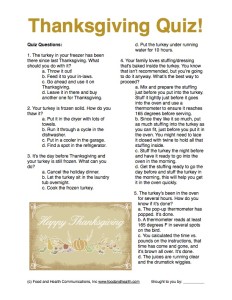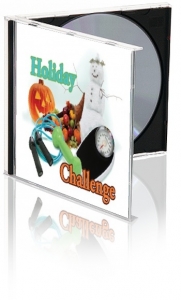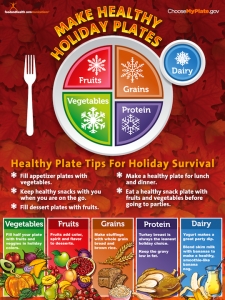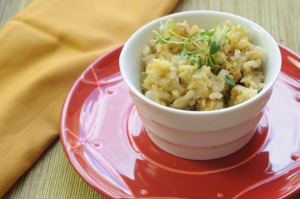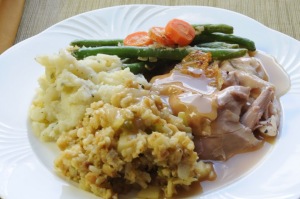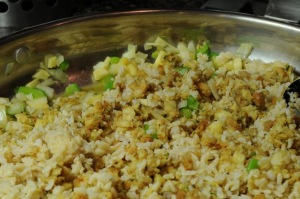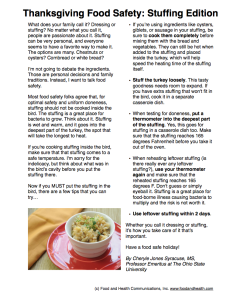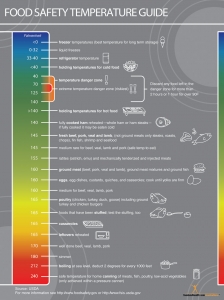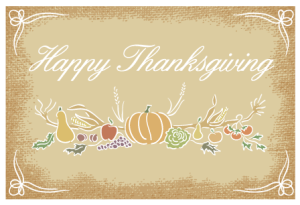 Nutrition, food safety, and cooking educators are always singing the same song before Thanksgiving. We talk about how to keep that large bird safe, standing on our soap boxes with research-based information about how people can get a foodborne illness from some common practices. But does anyone listen?
Nutrition, food safety, and cooking educators are always singing the same song before Thanksgiving. We talk about how to keep that large bird safe, standing on our soap boxes with research-based information about how people can get a foodborne illness from some common practices. But does anyone listen?
Common responses include “this is how I’ve always done it” and “no one’s died, yet.” Facing that kind of attitude, it’s hard to encourage change.
So, I’ve decided to turn the tables. Here’s a fun quiz that addresses some of the common mistakes people make when cooking a large meal at home. Perhaps if you make people laugh at their mistakes, then give them some practical answers about why they should respect food safety rules, they might change their attitude and practices.
Believe it or not, these are questions and responses from real people that I’ve heard over the many years I’ve been teaching food safety. I couldn’t make this stuff up!
Pick the best answer to each question.
1. The turkey in your freezer has been there since last Thanksgiving. What should you do with it?
a. Throw it out!
b. Feed it to your in-laws.
c. Go ahead and use it on Thanksgiving.
d. Leave it in there and buy another one for Thanksgiving.
2. Your turkey is frozen solid. How do you thaw it?
a. Put it in the dryer with lots of towels.
b. Run it through a cycle in the dishwasher.
c. Put in a cooler in the garage.
d. Find a spot in the refrigerator.
3. It’s the day before Thanksgiving and your turkey is still frozen. What can you do?
a. Cancel the holiday dinner.
b. Let the turkey sit in the laundry tub overnight.
c. Cook the frozen turkey.
d. Put the turkey under running water for 10 hours.
4. Your family loves stuffing/dressing that’s baked inside the turkey. You know that isn’t recommended, but you’re going to do it anyway. What’s the best way to proceed?
a. Mix and prepare the stuffing just before you put into the turkey. Stuff it lightly just before it goes into the oven and use a thermometer to make sure it reaches 165 degrees before serving.
b. Since they like it so much, put as much stuffing into the turkey as you can fit, just before you put it in the oven. You might need to lace it closed with twine to hold all that stuffing inside.
c. Stuff the turkey the night before and have it ready to go into the oven in the morning.
d. Get the stuffing ready to go the day before and stuff the turkey in the morning, this will help you get it in the oven quickly.
5. The turkey’s been in the oven for several hours. How do you know if it’s done?
a. The pop-up thermometer has popped. It’s done.
b. A thermometer reads at least 165 degrees F in several spots on the bird.
c. You calculated the time vs. pounds on the instructions, that time has come and gone and it’s brown all over. It’s done.
d. The juices are running clear and the drumstick wiggles.
ANSWERS:
- C. A turkey that has been kept solidly frozen for an entire year will be safe to eat. The quality may be lower than a turkey kept in the freezer for a shorter time. One suggestion is to prepare it for a family meal before Thanksgiving. This will give you a recent turkey-cooking experience, so cooking on the big day won’t be so intimidating. Actually, answers B and D could also be correct, since there would be no reason not to invite your in-laws to your practice dinner or the holiday. You really could save the older turkey for after the holiday, but the longer it sits in the freezer, the lower the quality will be.
- D. Thawing the turkey in the refrigerator is the safest method. It takes one day for each four to five pounds of turkey to thaw. The other answers don’t keep the outside of the bird cold enough while the inside is still frozen. Also, it’s really best to use home appliances for their originally-designated purposes. Some of those ideas are just yucky!
- C. Turkeys can be cooked directly from the freezer; the cooking time may be as much as 50% more than a thawed turkey. There also won’t be an opportunity to stuff it. Instead, you could bake your stuffing in a casserole dish. Now what about those giblets in the bag? Check the turkey throughout the cooking process, and when it has defrosted enough, you can carefully remove the giblet bags with tongs. You could also thaw a turkey by submerging it in cold tap water. The water should be changed every 30 minutes, and this method will take 10-12 hours for a 20-pound turkey. It also requites lots of water. The turkey should be cooked immediately after thawing. Oh, and if you purchased a pre-stuffed turkey, then it should always be cooked directly from its frozen state.
- A. The ingredients can be prepared the day before, but keep the wet and dry ingredients separate. Make sure that the wet ingredients (chopped vegetables, broth, and cooked meats) are safely stored in the refrigerator. Mix the wet and dry ingredients together just before filling the turkey cavity, and even then, only fill it loosely. Cook the turkey immediately after stuffing it. Use a food thermometer to make sure the center of the stuffing reaches a safe minimum internal temperature of 165 °F.
- B. The only way that you can be absolutely sure that the turkey is done is to use a thermometer. The minimum temperature to which a turkey should be cooked is 165 degrees Fahrenheit. Check the internal temperature at several locations, including the thigh and the thickest part of the breast. Pop-up timers may pop too early because of fat pooling at the tip, so always use another thermometer to double check. The National Turkey Federation recommends cooking turkey to a higher temperature than the minimum. While 165 degrees F is the minimum safe temperature, they say that people like the quality more (and it will be easier to carve and slice) if it’s cooked to a higher temperature. They frequently suggest 180 degrees F instead.
I hope you and your clients have as much fun with this quiz as I had writing it. Have a safe and wonderful Thanksgiving!
By Cheryle Jones Syracuse, MS, Professor Emeritus at The Ohio State University
Here’s a free PDF handout of the quiz, just for you!
There are lots of other holiday resources in the Nutrition Education Store! Which ones will make your life easier?



